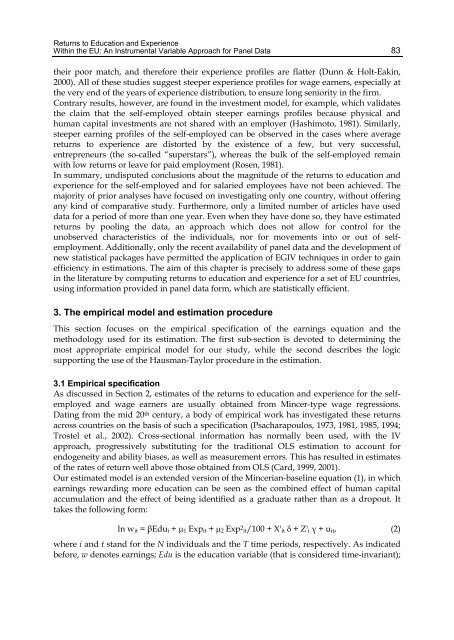The Limits of Mathematics and NP Estimation in ... - Chichilnisky
The Limits of Mathematics and NP Estimation in ... - Chichilnisky
The Limits of Mathematics and NP Estimation in ... - Chichilnisky
- No tags were found...
Create successful ePaper yourself
Turn your PDF publications into a flip-book with our unique Google optimized e-Paper software.
Returns to Education <strong>and</strong> ExperienceWith<strong>in</strong> the EU: An Instrumental Variable Approach for Panel Data 83their poor match, <strong>and</strong> therefore their experience pr<strong>of</strong>iles are flatter (Dunn & Holt-Eak<strong>in</strong>,2000). All <strong>of</strong> these studies suggest steeper experience pr<strong>of</strong>iles for wage earners, especially atthe very end <strong>of</strong> the years <strong>of</strong> experience distribution, to ensure long seniority <strong>in</strong> the firm.Contrary results, however, are found <strong>in</strong> the <strong>in</strong>vestment model, for example, which validatesthe claim that the self-employed obta<strong>in</strong> steeper earn<strong>in</strong>gs pr<strong>of</strong>iles because physical <strong>and</strong>human capital <strong>in</strong>vestments are not shared with an employer (Hashimoto, 1981). Similarly,steeper earn<strong>in</strong>g pr<strong>of</strong>iles <strong>of</strong> the self-employed can be observed <strong>in</strong> the cases where averagereturns to experience are distorted by the existence <strong>of</strong> a few, but very successful,entrepreneurs (the so-called “superstars”), whereas the bulk <strong>of</strong> the self-employed rema<strong>in</strong>with low returns or leave for paid employment (Rosen, 1981).In summary, undisputed conclusions about the magnitude <strong>of</strong> the returns to education <strong>and</strong>experience for the self-employed <strong>and</strong> for salaried employees have not been achieved. <strong>The</strong>majority <strong>of</strong> prior analyses have focused on <strong>in</strong>vestigat<strong>in</strong>g only one country, without <strong>of</strong>fer<strong>in</strong>gany k<strong>in</strong>d <strong>of</strong> comparative study. Furthermore, only a limited number <strong>of</strong> articles have useddata for a period <strong>of</strong> more than one year. Even when they have done so, they have estimatedreturns by pool<strong>in</strong>g the data, an approach which does not allow for control for theunobserved characteristics <strong>of</strong> the <strong>in</strong>dividuals, nor for movements <strong>in</strong>to or out <strong>of</strong> selfemployment.Additionally, only the recent availability <strong>of</strong> panel data <strong>and</strong> the development <strong>of</strong>new statistical packages have permitted the application <strong>of</strong> EGIV techniques <strong>in</strong> order to ga<strong>in</strong>efficiency <strong>in</strong> estimations. <strong>The</strong> aim <strong>of</strong> this chapter is precisely to address some <strong>of</strong> these gaps<strong>in</strong> the literature by comput<strong>in</strong>g returns to education <strong>and</strong> experience for a set <strong>of</strong> EU countries,us<strong>in</strong>g <strong>in</strong>formation provided <strong>in</strong> panel data form, which are statistically efficient.3. <strong>The</strong> empirical model <strong>and</strong> estimation procedureThis section focuses on the empirical specification <strong>of</strong> the earn<strong>in</strong>gs equation <strong>and</strong> themethodology used for its estimation. <strong>The</strong> first sub-section is devoted to determ<strong>in</strong><strong>in</strong>g themost appropriate empirical model for our study, while the second describes the logicsupport<strong>in</strong>g the use <strong>of</strong> the Hausman-Taylor procedure <strong>in</strong> the estimation.3.1 Empirical specificationAs discussed <strong>in</strong> Section 2, estimates <strong>of</strong> the returns to education <strong>and</strong> experience for the selfemployed<strong>and</strong> wage earners are usually obta<strong>in</strong>ed from M<strong>in</strong>cer-type wage regressions.Dat<strong>in</strong>g from the mid 20 th century, a body <strong>of</strong> empirical work has <strong>in</strong>vestigated these returnsacross countries on the basis <strong>of</strong> such a specification (Psacharapoulos, 1973, 1981, 1985, 1994;Trostel et al., 2002). Cross-sectional <strong>in</strong>formation has normally been used, with the IVapproach, progressively substitut<strong>in</strong>g for the traditional OLS estimation to account forendogeneity <strong>and</strong> ability biases, as well as measurement errors. This has resulted <strong>in</strong> estimates<strong>of</strong> the rates <strong>of</strong> return well above those obta<strong>in</strong>ed from OLS (Card, 1999, 2001).Our estimated model is an extended version <strong>of</strong> the M<strong>in</strong>cerian-basel<strong>in</strong>e equation (1), <strong>in</strong> whichearn<strong>in</strong>gs reward<strong>in</strong>g more education can be seen as the comb<strong>in</strong>ed effect <strong>of</strong> human capitalaccumulation <strong>and</strong> the effect <strong>of</strong> be<strong>in</strong>g identified as a graduate rather than as a dropout. Ittakes the follow<strong>in</strong>g form:ln w it = βEdu i + 1 Exp it + 2 Exp 2 it/100 + X' it + Z' i γ + u it , (2)where i <strong>and</strong> t st<strong>and</strong> for the N <strong>in</strong>dividuals <strong>and</strong> the T time periods, respectively. As <strong>in</strong>dicatedbefore, w denotes earn<strong>in</strong>gs; Edu is the education variable (that is considered time-<strong>in</strong>variant);








